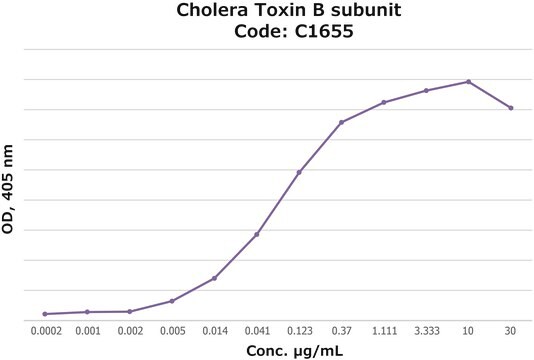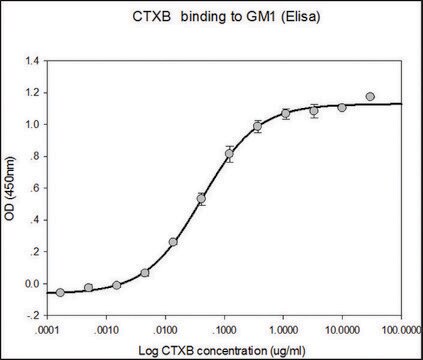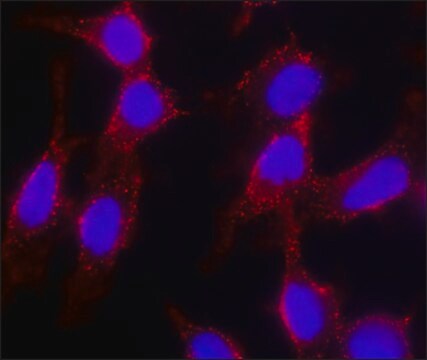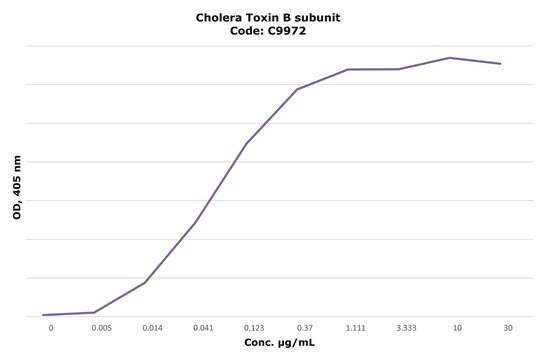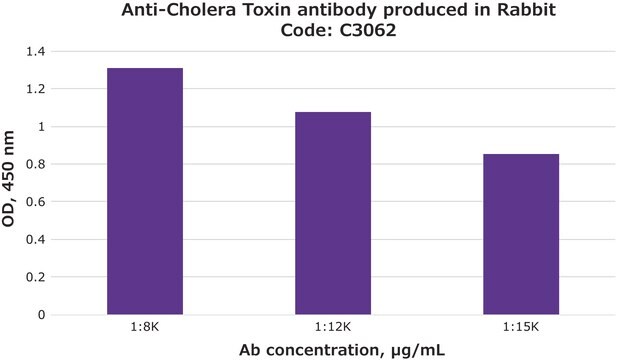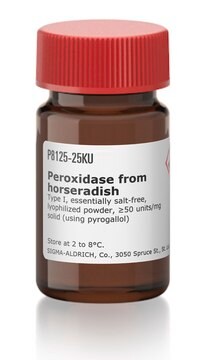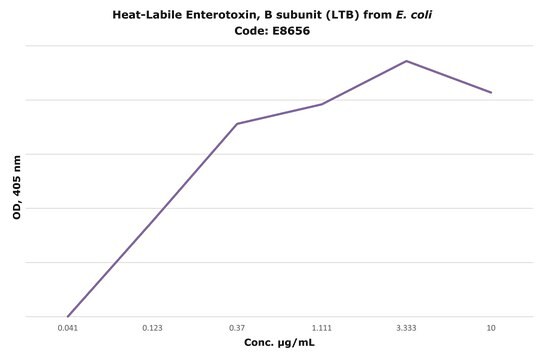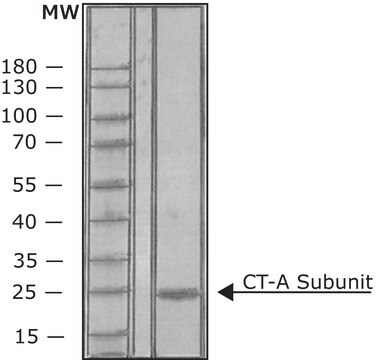추천 제품
결합
peroxidase conjugate (Contains ~ 2 moles HRP/mole of CTB. ~100 μg HRP conjugated to ~45 μg CTB)
Quality Level
양식
lyophilized powder
peroxidase activity
>100 U/mg, pH 6.0, 20 °C
분자량
pentamer 57 kDa
~12 kDa
solubility
H2O: soluble 10 mg/mL
저장 온도
2-8°C
SMILES string
CCOc1ccccc1C(=O)Nc2ccc(Cl)c(c2)C(F)(F)F
InChI
1S/C16H13ClF3NO2/c1-2-23-14-6-4-3-5-11(14)15(22)21-10-7-8-13(17)12(9-10)16(18,19)20/h3-9H,2H2,1H3,(H,21,22)
InChI key
YDXZSNHARVUYNM-UHFFFAOYSA-N
유사한 제품을 찾으십니까? 방문 제품 비교 안내
일반 설명
Cholera toxin is produced by Vibrio cholerae species, and the gene ctxB (cortexillin II) encodes the B subunit of the toxin. Cholera toxin belongs to the AB2 family of toxins. It is composed of a single A subunit of 28 kDa and five B subunits of 11 kDa.
특이성
HRP activity exceedes 100 pyrogallol units per mg of HRP in the CTB-HRP conjugate. Activity: 10-30 pyrogallol units per vial.
애플리케이션
Cholera toxin B subunit conjugated to peroxidase (CB-HRP) has been shown to be a more effective retrograde and transganglionic tracer for pelvic primary afferents from the urinary bladder than wheat germ agglutinin-horseradish peroxidase or isolectin B4-horseradish peroxidase. Retrograde labeling with CB-HRP has been demonstrated in sympathetic pre-ganglionic neurons as well as in cells of the fastigial nuclei. It is also an effective anterograde tracer for the study of axonal and terminal labeling in the brain stem. Cholera Toxin B subunit has been used:
- In the isolation of lipid rafts and analysis of B-cell receptor distribution, signaling and ubiquitination.
- In the staining of lipid rafts in brain tissues.
- As a transganglionic tracer to determine the central projections of the anterior ethmoidal nerve in rat.
생화학적/생리학적 작용
Cholera toxin gains entry into the host cell via host′s glycolipid transport pathway. The toxin is an essential factor for the pathogenesis of cholera. The ToxR gene is responsible for the activation of the expression of the gene coding cholera toxin.
The cholera toxin B subunit is used for track tracing in neurological research, taking advantage of GM1 ganglioside binding and retrograde transport.
The cholera toxin B subunit is used for track tracing in neurological research, taking advantage of GM1 ganglioside binding and retrograde transport. Tissue culture cells treated with cholera toxin are not killed and tissues of animals do not become necrotic.
포장
Prepared and packaged using aseptic technique and sealed under vacuum.
주의사항
Do not freeze.
단위 정의
Unit definition: One pyrogallol unit converts 1 mg of pyrogallol to purpurogallin in 20 seconds at pH 6.0 at 20 °C.
물리적 형태
Lyophilized powder containing 11-13% protein with the balance consisting of phosphate buffer and sodium chloride.
재구성
Reconstitution of the vial with 100 μl of water will yield a final solution containing: 1 mg/mL HRP, 0.45 mg/ml CTB, 10 mM phosphate buffer and 150 mM NaCl. Swirl bottles gently during reconstitution. Avoid vigorous pipetting of solutions that may lead to foaming. Solutions can be sterile filtered through a 0.2 μm filter. Store the reconstituted solutions at 2-8 °C.
신호어
Danger
유해 및 위험 성명서
예방조치 성명서
Hazard Classifications
Resp. Sens. 1
Storage Class Code
13 - Non Combustible Solids
WGK
WGK 2
Flash Point (°F)
Not applicable
Flash Point (°C)
Not applicable
Physiological-range temperature changes modulate cognate antigen processing and presentation mediated by lipid raft-restricted ubiquitinated B cell receptor molecules
Katkere B, et al.
Journal of immunology (Baltimore, Md. : 1950), 1001653-1001653 (2010)
Clinical Toxicology, 35-35 (2014)
Vibrio Cholerae: Genomics and Molecular Biology, 71-71 (2008)
Bhuvana Katkere et al.
Journal of immunology (Baltimore, Md. : 1950), 185(9), 5032-5039 (2010-09-28)
BCR-mediated Ag processing and presentation is critical to the initiation and control of a humoral immune response. Trafficking of internalized Ag-BCR complexes to intracellular Ag processing compartments is driven by ubiquitination of the cytoplasmic domain of the BCR. Using a
Ibrahim Ramirez-Soto et al.
Cellular physiology and biochemistry : international journal of experimental cellular physiology, biochemistry, and pharmacology, 56(4), 382-400 (2022-08-25)
Alpha synuclein (αSN) is a widely distributed protein in vertebrates whose physiological significance in many tissues remains unclear, being a key protein present in neurodegenerative disease such as Parkinson's Disease, Lewy Body Dementia, and in Sporadic-Inclusion Body Myositis. We search
자사의 과학자팀은 생명 과학, 재료 과학, 화학 합성, 크로마토그래피, 분석 및 기타 많은 영역을 포함한 모든 과학 분야에 경험이 있습니다..
고객지원팀으로 연락바랍니다.